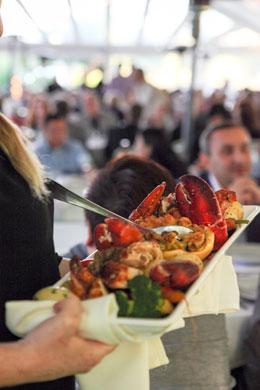Asia’s appetite for BC seafood growing

By Mata Press Service
In a remote area northwest of Vancouver Island called Kyuquot Sound, sablefish, a Japanese delicacy for decades, is gently cultured in pristine, cold, deep water pens.
After about 36 months, the sablefish, also known as black cod, are harvested from their deep water habitat using a traditional Japanese system to prevent tissue damage and end up as sashimi-grade fish on the other side of the ocean.
Further up north on Vancouver Island off Campbell River, salmon farmers can’t keep up with the demand for their world renowned sustainable seafood.
Along the same coast in the Baynes, Desolation, and Okeover Sounds, oysters, clams, and mussels farmed there in naturally nutrient rich areas for over 30 years have gained global recognition for taste and quality.
While most in Canada have feasted and reaped the health benefits from British Columbia’s waters, Asia is now waking up quickly to the bounty of the same seas.
This week dozens of buyers, foodies and chefs from Asia and rest of the world will congregate at the BC Shellfish and Seafood Festival in the Comox Valley on Vancouver Island to taste and buy a variety of local aquaculture products.
A trade expo during the week will also bring together leading aquaculture businesses & suppliers, seafood & shellfish producers, chefs, exporters and educators to discuss and explore innovations, challenges and opportunities around the Pacific Northwest seafood sector.
“The BC Shellfish and Seafood Festival and the BC Seafood Expo attracts incredible interest from a range of international media, as well as seafood buyers,” said John Watson, the executive director of the Comox Valley Economic Development and Tourism agency.
“This year the visiting nations include, Korea, Indonesia, Malaysia, Japan, Philippines, USA, China, Vietnam and India,” he said.
“Over the last two years the BC Seafood Festival has worked with the BC Salmon Farmers and BC Shellfish Growers to host 40 seafood buyers each year – the majority from key Asian markets,” said Jeremy Dunn, Executive Director of the BC Salmon Farmers Association.
Over that time, sales of salmon alone into Asia has grown by more than four times the volume from under $10-million in value to almost $40-million in value.
B.C. is also leading the way in achieving third party certification for its farm-raised salmon, said Dunn adding that as of now 15% of active Atlantic salmon farms in BC are certified to the ASC standard – a higher rate than any farming region in the world.
This week, Seafood Watch standards of the world-renowned Monterey Bay Aquarium announced that farmed salmon, certified by the Aquaculture Stewardship Council (ASC), have advanced in their seafood ranking to a ‘Good Alternative’.
This moves ASC-certified farmed salmon onto the program’s recommended list of seafood for consumers to buy.
It is, not only Japan, Korea and China that have grown a taste for BC salmon and shellfish. India is also awakening to the health benefits of our seafood.
Research has shown that people of South Asian descent are two-to-three times more likely to experience heart disease, kidney disease, stroke and diabetes – and ten years earlier – compared to other ethnic groups.
“India has a great costal cuisine and salmon is becoming increasingly popular in India because of its taste and health benefits,” said Chindi Varadarajulu, one of the chefs specially flown in to showcase her Indian fish curry in Comox.
“I am hoping we can get more BC salmon and shellfish in India,” said Varadarajulu, who operates L’attitude 49, a unique destination restaurant within the Grande Bay Resort and Spa.
The growing demand for BC seafood, especially salmon in Asia comes on the heels of growing concerns by a variety international organizations about the depletion of ocean stocks.
Nearly a third of the world’s fish stock is being “overfished” — harvested at biologically unsustainable levels — according to assessments by the United Nations. In part, that is because Asians are hungry, and ready to pay, for its regional bounty.
A recent report by the UN’s Food and Agriculture Organization found that Asians ate 99m tons of fish in 2013 — about 70 per cent of the 140m tons that were available for human consumption. Fish meal production — made from smaller fish that are less valuable — is also on the rise for use in feeding livestock and to support aquafarms.
BC Seafood by the numbers
In 2015, B.C. produced more than $40 million of farmed oysters, almost $11 million of farmed clams, and $5.5 million of mussels and other shellfish.
Global sales of fresh B.C farm-raised salmon reached a record $745-million CAD in 2016 with exports to 12-markets valued over $544-million.
The volume of salmon raised in B.C. exported to Asia increased 40% over 2015’s record volume with more than 4.7-million kilograms of fresh salmon exported. China and Japan continue to be the top two Asian destinations for exports, with South Korea now emerging as a key growth market.
Overall Canadian exports of farm-raised salmon reached over $950-million, with the total value of Canadian farm-raised seafood exports over $1-billion.
B.C. accounts for 58% of all Canadian exports of farm-raised salmon. Salmon farming has a total economic impact of more than $1.1-billion in British Columbia and accounts for more than 5,000 total jobs.
Salmon farmers are working closely with coastal First Nations with 20 social and economic agreements in place. 78% of the B.C. harvest is from farms covered under First Nation Agreements.









